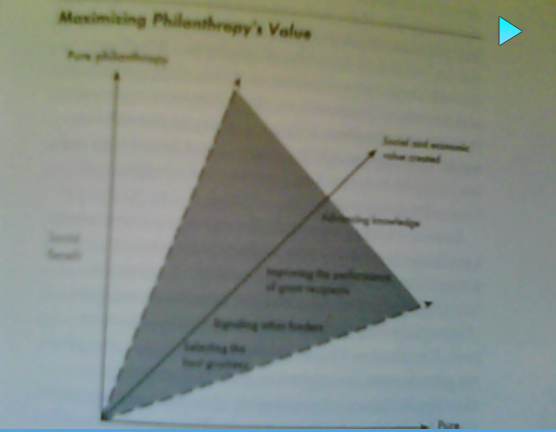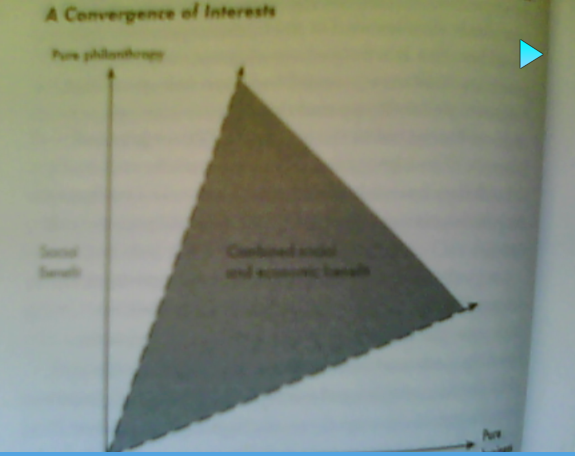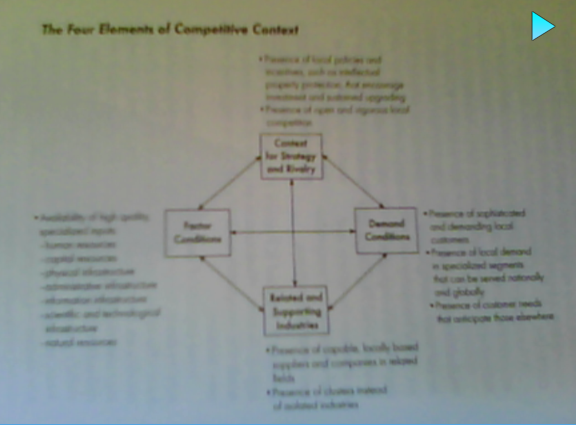Porter and Kramer (2002)
General Review:
Core Theory (logical explanation or testable model of interaction):
P31 “Corporations can use their charitable efforts to improve their competitive context – the quality of the business environment in the location or locations they operate.” Enhancing the context brings social and economic goals into alignment and improves business prospects, and enables the business to leverage its capabilities and relationships in support of charitable causes.
Core concepts (abstract idea or a mental symbol):
Cluster of interconnected companies, supplier, related industries and specialized institutions in a particular field creating national competitive advantage.
Core framework (structure used to outline, address or solve complex issues):
Cluster conditions influencing competitive context:
- Factor conditions p38 “Achieving high levels of productivity depends on the presence of trained workers, high-quality scientific and technological institutions, adequate physical infrastructure, transparent and efficient administrative processes and available resources. All are areas that philanthropy can influence.”
- Demand conditions – Sophisticated customers create insight into emerging customer needs
- Context for strategy and rivalry – supporting fair trade and competition increase productivity
- Related and supporting industries – Nearby outsourcing and supporting industries enhance formation of clusters
New process to tighten CP to other business activities:
- Examine the competitive context in each of the company’s important geographic locations
- Review existing portfolio for fit to new paradigm
- Communal obligation (good citizenship)
- Goodwill building (stakeholders preferred causes)
- Strategic giving (focused)
- Asses potential giving initiatives against the four forms of value creation
- Seek opportunities for collective action within cluster
- Rigorously track and evaluate results
Core models (pattern, plan or description showing main object or workings of concept):
P34 Maximising Philanthropy value and
45 a convergence of interests
P36 Four elements creating cluster of competitive advantage




Methods used:
Cites:
Relatedness to objective:
Free riders not contributing in Corporate Philanthropy does not necessarily negate strategic value. Building relationships and clusters is needed.
P50 Innovation drives productivity. Greatest advances come from new and better approaches not efficiency. “The most powerful way to create social value, therefore, is by developing new means to address social problems and putting them into widespread practice.
Relatedness to questions:
P61 CISCO networking academy
Arguments/points made (set of one or more declarative sentences):
Criticises:
P55 “As for cause related marketing, it is marketing, not philanthropy, and it must stand on its own merits.”
Supports:
Friedman, Milton (2002) Capitalism and Freedom “The corporation is an instrument of the stockholders who own it. If the corporation makes a contribution, it prevents the individual stockholder from himself deciding how he should dispose of his funds”
P30 “The way most corporate philanthropy is practiced today, Friedman is right. The majority of corporate contribution programs are diffuse and unfocused.”
Critique:
Friedman for the two implicit assumptions 1) that social and economic objectives are separate and distinct 2) that corporations provide no greater benefit than individual donors.
(Friedman explained how free markets work, emphasizing his conviction that free markets have been shown to solve social and political problems that other systems have failed to address adequately.)






